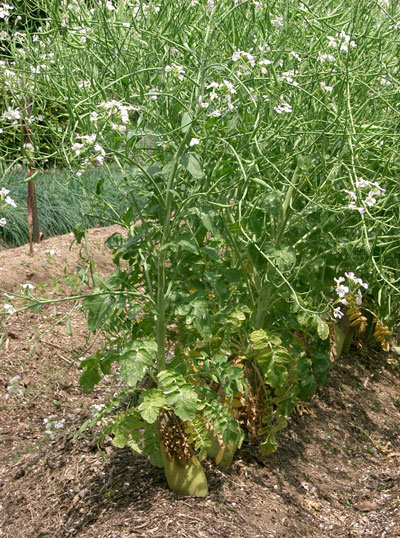Radish
Scientific Classification
| Kingdom: | Plantae |
| (unranked): | Angiosperms |
| (unranked): | Eudicots |
| (unranked): | Rosids |
| Order: | Brassicales |
| Family: | Brassicaceae |
| Genus: | Raphanus |
| Species: | R. sativus |
| Binomial name: | Raphanus sativus |
The radish (Raphanus sativus) is an edible root vegetable that comes from the family Brassicaceae. In early Roman times Europeans made this a household item. Radishes are a woody and cool season vegetable. Since it matures swiftly, you get a good crop in every season. Radish health benefits include phytochemicals with anti-carcinogenic properties and vitamin C that helps keep your body cells clean.
Anatomy
Radishes are available in colors of red and white; they are cylindrical to round in shape. The small rounded ones are excellent to eat raw in salads, because the longer ones of 15cm (6”) are good for cooking. Initially the fleshy portion tastes sweet, but if you leave this vegetable in the ground for a long time, it turns bitter. The leaves appear ornamentally arranged, ranging in size from 10 to 15 cm (4-6 “) in big cultivars.
Habitat

Photo by: KENPEI
China is the country where this radish possibly originated. The Orient and Japan in particular venerate and greatly value this vegetable. They use the white daikon radish as their staple food. The ancient Greeks valued this root-crop above others, and even made gold imitations of them. Quite early before the time of the pyramids, the Egyptians considered this crop as their routine food. It was also known to the Romans. Columbus and the early colonists brought this vegetable to America.
Soil and Planting
You get the finest radish when planted in easily crumbled soil, in cold weather and if constantly watered. The spring type of radish in particular grows very fast, hence it is essential to pluck them when tender. If you leave the radish in the garden for a much time, then it is good only as compost.
Planting
Around a month and a half after the end of spring frost date, sow your radish seeds straight into the ground, before which you add biodegradable fertilizers or old compost to the soil.
Radish requires sunlight. If you plant them in excess shade or under the shade of the adjacent vegetable plants, then they will use their entire energy to growing bigger leaves.
If you need a quick growing radish, then plant your seeds in holes as deep as 6 “, and for large, slow growing, sharp tasting winter type, then dig holes to a depth of 2 feet. Sow the seeds half-inch deep and space them 1 inch apart. For harvesting in the fall, sow your winter radish in the middle of summer.
Watering
Water radish to a reasonable extent. Very dry soil makes the radish lock up, condense and very pungent for consumption. On the contrary excess water makes the roots divide and decay. Do not allow the soil to completely dry up or leave it muddy.
Temperature and Humidity
Most of the spring type of radish grow within 30 days. Plant your radish in sequence, then you get a continuous growth of radishes. Stop sowing your radish seeds when the temperature reaches (65°) or more, because radish will not adjust heat and will fast turn into seeds.
Care
- Give your radish a steady supply of water in a properly drained soil.
- After 7 days of the plant growth, thin them to almost an inch apart, the outcome is astonishing.
Pests and Pesticides
Radishes attract cabbage maggots that at times, but rarely destroy the whole crop.
Sow your radish in the middle of cucumber; this will get rid of the cucumber beetles. Plant them close to spinach. Radish pulls the leafminers from the spinach and the harm these leafminers do to the radish will not hinder the radish from growing properly underground.
Harvest Month and Storage
- Except for certain varieties, radish grows after three weeks of planting and is ready for harvesting soon.
- Once they are mature, never leave them on the ground for some time, the radish will decay faster.
- Snip off the tops, short, wash and dry the radish properly, then put them in plastic bags and refrigerate.
- You can store radish greens separately for three days.
Varieties
In a broad sense, you can classify radish into four main grades (Spring, winter, fall and summer) They grow in different lengths, sizes, forms and colors like yellow, white, red, gray-black and pink. They have elongated and round roots.
The variety that matures late is “French Breakfast”, that does fine in normal heat.
“Burpee White”, White skin, spring variety.
Other Varieties Are:
Champion, The April Cross, Bunny Tail, Plum Purple and Cherry Belle.

Having discovered a fondness for insects while pursuing her degree in Biology, Randi Jones was quite bugged to know that people usually dismissed these little creatures as “creepy-crawlies”.







